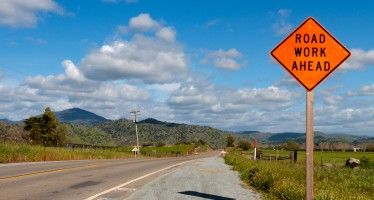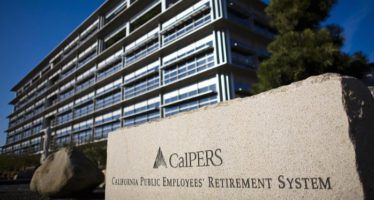Worst-case scenarios for CalSTRS and CalPERS
 Sometimes it’s good to consider worst-case scenarios. Maybe they won’t even happen, but it can help to look at every possibility. Two analysts have done that for California’s two biggest pension systems.
Sometimes it’s good to consider worst-case scenarios. Maybe they won’t even happen, but it can help to look at every possibility. Two analysts have done that for California’s two biggest pension systems.
As of the most current figures, the California Public Employees’ Retirement System is 76 percent funded and the California State Teachers’ Retirement System is 67 percent funded. Most bond advisers peg sufficient funding at 80 percent or higher, so both funds are close to that. Both funds project a 7.5 percent annual return on their investments.
As CalPERS explained last May on its website:
“Fact:
- “CalPERS investments have earned an average 7.6 percent annual return over the past 20 years and 9.4 percent over the past 30 years.
- “CalPERS investments earned 13.2 percent in Fiscal Year 2012-13.
- “CalPERS assumed rate of investment return is a long-term (20 years or more) average. Any given year is likely to be higher or lower than the assumed rate.”
And last July, CalSTRS stated on its website:
“Continued growth in the equity market, coupled with a bias to U.S. companies, fed a second year of healthy investment returns at the California State Teachers’ Retirement System (CalSTRS), which closed the 2013-14 fiscal year with an 18.66 percent return on its investments.
“The picture for the fiscal year July 1, 2013 to June 30, 2014 shows investment returns well above the actuarial assumed rate of 7.5 percent. On a long-term, portfolio-wide basis, CalSTRS’ returns reflect the following performance levels:
“11.2 percent over three years
“13.7 percent over five years
“7.7 percent over 10 years
“8.4 percent over 20 years.”
But when those numbers came out last year, David Crane warned, “A few above-par years will have little impact on pension costs for California’s governments because pension liabilities greatly exceed pension assets and continue growing at a rapid rate.” A Democrat, pension expert Crane advised former Gov. Arnold Schwarzenegger.
Worst case
So, what is the worst-case scenario? It’s that the pension funds make more modest growth, requiring taxpayers to pick up the tab for the gap between projections and reality.
Money manager John Mauldin looked at CalSTRS. Worst case, to be actually solvent he calculated CalSTRS requires an additional $30 billion per year starting now.
That $30 billion also is six times the $4.5 billion more a year CalSTRS concedes it needs to become solvent.
Ed Ring, Executive Director of the California Policy Center, likewise has estimated how much in annual payments it would cost to close his estimated $71 billion funding gap for CalSTRS. Using a 3.5 percent annual rate of return, Ring estimated the payment to fully fund CalSTRS would be $25.3 billion per year (Note: See Ring’s “Table: Impact of Lower Rates of Return on CalSTRS” in the embedded link).
Both Mauldin and Ring believe future CalPERS and CalSTRS pension fund rates of return on their investments are overly optimistic by half due to a stock market bubble and a failure to take economic recessions into account.
CalPERS funding
If it would take $30 billion per year more to fully fund CalSTRS, how much more would it take to also fund the even bigger CalPERS?
Ring described the problem of estimating the yearly payment to plug CalPERS’ pension funding gap:
“It’s worth noting that for CalPERS, we can’t even get data on how they break out their normal contributions and their unfunded contributions because doing so would require sifting through the financials of every one of their participating entities. But there is nothing uniquely troubling about CalSTRS. … Imagine what would happen if CalSTRS had to pay $25 billion per year … instead of what they actually paid in 2012, $5.8 billion?”
That is, a true accounting would be 4.3 times the current amount. He added, “Replicate these methods with nearly any pension fund in California, and you will almost always get similar results.”
Add them up: $25.3 billion for CalSTRS and $25 billion for CalPERS. Total = $50.2 billion.
That $50.2 billion needed to be fully funded would amount to 44 percent of the $113.3 billion for the state general fund Gov. Jerry Brown proposed in January for fiscal year 2015-16, which begins on July 1.
Again, this is a “worst case” scenario. It probably won’t come to pass. The U.S. and California economies may continue to perform as expected, with stock market and real estate investments continuing to lift up the funds’ bottom lines.
But the opposite also is something at least to keep in mind.
Related Articles
State’s largest ‘community choice’ energy program takes a hit
The community choice aggregation (CCA) movement has built considerable momentum in California in recent years. In CCA programs, groups of
Bill could make it easier to increase transportation taxes
A bill that a taxpayer group is calling an attack on Proposition 13 and which the California Chamber of Commerce
CA Supreme Court to review pension case with nationwide implications
Reigniting a perpetually smoldering debate with nationwide implications, the California State Supreme Court agreed to consider whether rules cracking down on




